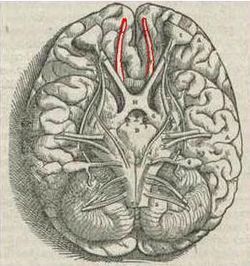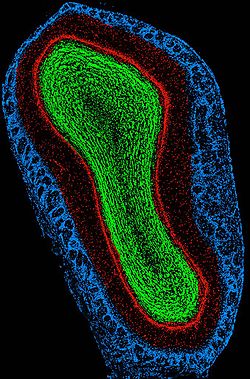- Olfactory bulb
-
Brain: Olfactory bulb 
Vesalius' Fabrica, 1543. Olfactory Bulbs and Olfactory tracts outlined in red 
Coronal image of mouse main olfactory bulb cell nuclei. Blue - Glomerular layer; Red - External Plexiform and Mitral cell layer; Green - Internal Plexiform and Granule cell layer. Top of image is dorsal aspect, right of image is lateral aspect. Scale, ventral to dorsal, is approximately 2mm. Latin bulbus olfactorius Gray's subject #189 826 System Olfactory NeuroNames hier-261 MeSH Olfactory+Bulb NeuroLex ID birnlex_1137 The olfactory bulb is a structure of the vertebrate forebrain involved in olfaction, the perception of odors.[1]
Contents
Anatomy
In most vertebrates, the olfactory bulb is the most rostral (forward) part of the brain. In humans, however, the olfactory bulb is on the inferior (bottom) side of the brain. The olfactory bulb is supported and protected by the cribriform plate of the ethmoid bone, which in mammals separates it from the olfactory epithelium, and which is perforated by olfactory nerve axons. The bulb is divided into two distinct structures: the main olfactory bulb and the accessory olfactory bulb.
Main olfactory bulb
The main olfactory bulb has a multi-layered cellular architecture. In order from surface to the center the layers are
- Glomerular layer
- External plexiform layer
- Mitral cell layer
- Internal plexiform layer
- Granule cell layer
The olfactory bulb transmits smell information from the nose to the brain, and is thus necessary for a proper sense of smell. As a neural circuit, the glomerular layer receives direct input from olfactory nerves, made up of the axons from approximately ten million olfactory receptor neurons in the olfactory mucosa, a region of the nasal cavity. The ends of the axons cluster in spherical structures known as glomeruli such that each glomerulus receives input primarily from olfactory receptor neurons that express the same olfactory receptor. Glomeruli are also permeated by dendrites from neurons called mitral cells, which in turn output to the olfactory cortex. Numerous interneuron types exist in the olfactory bulb including periglomerular cells which synapse within and between glomeruli, and granule cells which synapse with mitral cells.
As a neural circuit, the olfactory bulb has one source of sensory input (axons from olfactory receptor neurons of the olfactory epithelium), and one output (mitral cell axons). As a result, it is generally assumed that it functions as a filter, as opposed to an associative circuit that has many inputs and many outputs. However, the olfactory bulb also receives "top-down" information from such brain areas as the amygdala, neocortex, hippocampus, locus coeruleus, and substantia nigra. With this in mind, its potential functions can be placed into four non-exclusive categories:
- discriminating among odors
- enhancing sensitivity of odor detection
- filtering out many background odors to enhance the transmission of a few select odors
- permitting higher brain areas involved in arousal and attention to modify the detection or the discrimination of odors
While all of these functions could theoretically arise from the olfactory bulb's circuit layout, it is unclear which, if any, of these functions are performed exclusively by the olfactory bulb. By analogy to similar parts of the brain such as the retina, many researchers have focused on how the olfactory bulb filters incoming information from receptor neurons in space, or how it filters incoming information in time. At the core of these proposed filters are the two classes of interneurons; the periglomerular cells, and the granule cells.
The basal dendrites of mitral cells are connected to interneurons known as granule cells, which by some theories produce lateral inhibition between mitral cells. It is not clear what the functional role of lateral inhibition would be, though it may be involved in boosting the signal-to-noise ratio of odor signals by silencing the basal firing rate of surrounding non-activated neurons. The synapse between mitral and granule cells is of a rare class of synapses that are "dendro-dendritic" which means that both sides of the synapse are dendrites that release neurotransmitter. In this specific case, mitral cells release the excitatory neurotransmitter glutamate, and granule cells release the inhibitory neurotransmitter Gamma-aminobutyric acid (GABA). As a result of its bi-directionality, the dendro-dendritic synapse can cause mitral cells to inhibit themselves (auto-inhibition), as well as neighboring mitral cells (lateral inhibition).
Olfaction is distinct from the other sensory systems where peripheral sensory receptors have a relay in the diencephalon. Therefore the olfactory bulb plays this role for the olfactory system.
Accessory olfactory bulb
The accessory olfactory bulb, which resides on the dorsal-posterior region of the main olfactory bulb, forms a parallel pathway independent from the main olfactory bulb. It is the second processing stage of the accessory olfactory system. It receives axonal input from the vomeronasal organ, a distinct sensory epithelium from the main olfactory epithelium that detects pheromones, among other chemical stimuli. As in the main olfactory bulb, axonal input to the accessory olfactory bulb forms synapses with mitral cells within glomeruli. However, mitral cells in the accessory olfactory bulb project their axons to targets in the amygdala and hypothalamus, where they may influence aggressive and mating behavior. The olfactory bulb also helps humans sense when danger is near by. There is evidence against the presence of a functional accessory olfactory bulb in humans and other higher primates[2] .
Evolution
 Fossil endocast of a Tyrannosaurus cranial vault, showing extensive olfactory bulb (structure to the left)
Fossil endocast of a Tyrannosaurus cranial vault, showing extensive olfactory bulb (structure to the left)
Comparing the structure of the olfactory bulb among vertebrate species, such as the leopard frog and the lab mouse, reveals that they all share the same fundamental layout (five layers containing the nuclei of three major cell types; see "Anatomy" for details), despite being dissimilar in shape and size. Of note, a similar structure is shared by the analogous olfactory center in the fruit fly Drosophila melanogaster, the antennal lobe. One possibility is that vertebrate olfactory bulb and insect antennal lobe structure may be similar because they contain an optimal solution to a computational problem experienced by all olfactory systems and thus may have evolved independently in different phyla.
References
- ^ "olfactory bulb". http://www.sci.uidaho.edu/med532/olfacbulb.htm. Retrieved 2009-11-20.
- ^ "Pheromonal communication in vertebrates". Nature 444: 308–315. 2006. doi:10.1038/nature05404.
- Shepherd, G. The Synaptic Organization of the Brain, Oxford University Press, 5th edition (November, 2003). ISBN 0-19-515956-X
- Halpern, M; Martínez-Marcos, A (2003). "Structure and function of the vomeronasal system: An update". Progress in neurobiology 70 (3): 245–318. doi:10.1016/S0301-0082(03)00103-5. PMID 12951145.
- Ache, BW; Young, JM (2005). "Olfaction: Diverse species, conserved principles". Neuron 48 (3): 417–30. doi:10.1016/j.neuron.2005.10.022. PMID 16269360.
Additional images
See also
External links
- Roche Lexicon - illustrated navigator, at Elsevier 13048.000-1
- Glomerular Response Archive Leon & Johnson UC Irvine
- Olfactory Systems Laboratory at University of Utah
Human brain, cerebrum, Interior of the cerebral hemispheres—Rostral Basal ganglia and associated structures (TA A14.1.09.321–552, GA 9.832–837) Basal ganglia Ventral striatumOtherInternal capsule (Anterior limb · Genu · Posterior limb, Optic radiation)
Corona radiata · External capsule · Extreme capsule
Pallidothalamic tracts: Thalamic fasciculus (Ansa lenticularis, Lenticular fasciculus) · Subthalamic fasciculusRhinencephalon Other basal forebrain Diagonal band of Broca · Stria terminalisArchicortex:
Hippocampal formation/
Hippocampus anatomySensory system: Olfactory system / Olfaction / Rhinencephalon (TA 15.1, GA 10.992) Olfactory epithelium Olfactory nerve: 1° neuron Olfactory nerve: 2° neuron Lateral olfactory stria/
Primary olfactory cortexPiriform cortex · EC-hippocampus system (Entorhinal cortex, Hippocampal formation) · Prepyriform area · Periamygdaloid cortex
Stria medullaris → Habenular nuclei
Amygdala → Stria terminalis → Hypothalamus
Medial forebrain bundle → HypothalamusMedial olfactory stria Categories:
Wikimedia Foundation. 2010.







